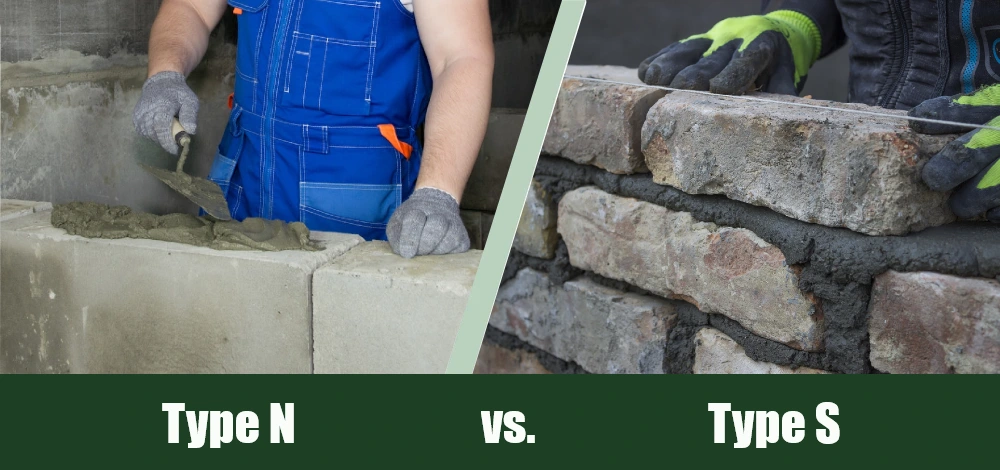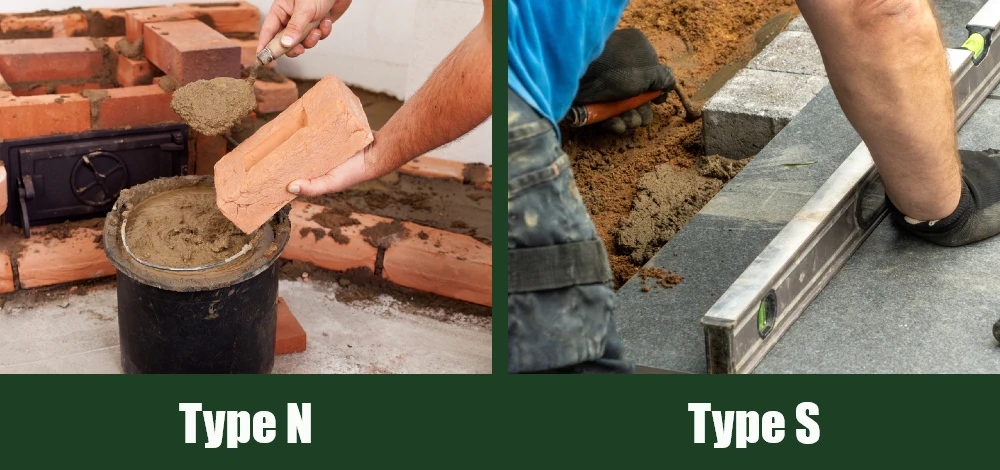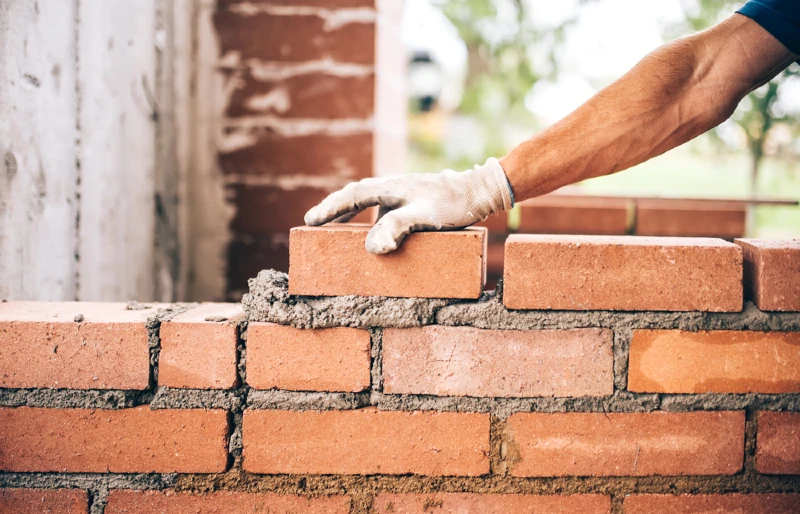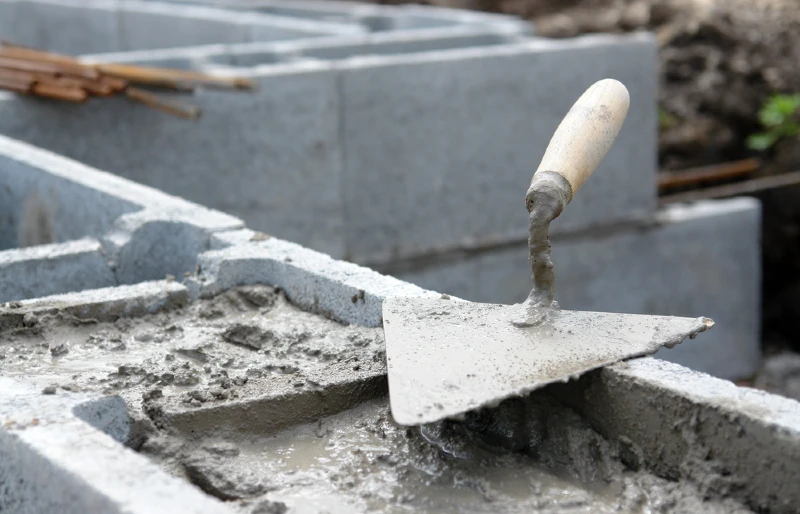Type N vs. Type S Mortar: What’s the Difference? (With Pictures)
-
Codee Chessher
- Last updated:

Mortar is a mix of cement, sand, and water that helps bond together bricks, stones, or other masonry units. To suit different types of jobs, mortar is categorized into types, like type N and type S. There are others, but let’s focus on those two. What are they used for, and how do they differ? Let’s find out the answers to those questions and more relevant info down below.
At A Glance

- 1 part cement, 1 part lime, 6 parts sand
- Withstands 1,500 to 2,400 PSI
- Mainly used for above-grade walls
- Medium bond & compressive strength
- 2 parts cement, 1 part lime, 9 parts sand
- Withstands 2,300 to 3,000 PSI
- Used for foundations, retaining walls, and other structural elements
- High bond & compressive strength
Overview of Type N Mortar:

Type N mortar is a general-purpose mortar with a relatively even combination of Portland cement, hydrated lime, and sand. This is a solid blend of ingredients that’s become a gold standard for brick and blockwork. If your home has brick, we’d bet cash there’s dried Type N mortar in there.
This mortar has a compressive strength of up to 2,400 PSI, which is how many pounds of pressure per square inch it can withstand. After installation, the mortar has to be kept wet for a couple of days to start curing, or else hot air could sap the moisture out of it. That would compromise the mortar’s compressive strength, so it’s especially important.
The biggest downside of Type N mortar is that it’s lackluster at holding up to extreme weather like flooding and cold snaps, which could cause the mortar to erode, chip, or crack. Poorly installed mortar is more likely to fall prey to this type of damage, and you can prevent it by not using Type N where inclement weather is a concern.
When to Choose
Type N mortar is perhaps the ultimate general-purpose mortar for masonry. You can use it to bond non-load-bearing walls, chimneys, fireplaces, decorative brickwork, and more. Type N is also useful for repointing old brickwork when the mortar is leaking indoors. It’s perfect for DIY projects as well because of its affordable cost and shorter cure time versus Type S but can’t compete when durability is important.
Because of its lower compressive strength, you won’t find Type N mortar below grade in foundations often, but it’s sometimes used to construct retaining and garden walls outdoors.
Cost & Availability
Type N mortar is the most widely available type of mortar because it has a lower but balanced proportion of cement, and you won’t have any trouble finding it at most home improvement stores. Unless you’re doing some heavy-duty building where compressive strength is essential, Type N is a great default choice for masonry work and DIY jobs.
- Cost-effective
- Moderate compressive & bonding strength
- Widely available
- Perfect for general-purpose brickwork
- More susceptible to extreme weather conditions
- Weaker than Type S mortar
- Not suitable for load-bearing structural elements
Overview of Type S Mortar:

Type S mortar is the good stuff they use to make foundations, retaining walls, dams, manholes, sewers, and anywhere strength and moisture are issues. It has a higher cement content than Type N, making it thicker and more difficult to work with, but that also helps make Type S mortar more water resistant. That’s a big reason they use it in areas that get a lot of rain or flooding. Whereas Type N might erode or crack, Type S stays strong.
When to Choose
Type S mortar’s impressive compressive and bonding strength make it useful for not only stone and brick, but other structural elements like metal, precast concrete, or other heavy building materials. All this comes at a cost, though. Because Type S is harder to work with, it has more limited uses.
Use Type S mortar to create an ultra-strong load-bearing wall, retaining wall, or to support structural elements like columns. Type S is also excellent at standing up to high winds. Even better, you can use Type S to fix flaws or cracks in structural elements without ripping it all out. It is hard to work with, however.
Interestingly, Type S mortar is compatible with heavier structural materials that Type N can’t bond because of weight. While Type N is stuck in the masonry field, Type S can be used for general purpose construction when durability is of the utmost importance.
Cost & Availability
Because Type S mortar has much more cement in it and offers greater compressive strength, it costs significantly more than Type N. While your average home improvement store may have it, you’re less likely to find it on shelves than regular ol’ Type N. In some cases, you might have to visit a masonry or construction supply store or make a special online order for the stuff.
- Very high compressive strength
- Less susceptible to moisture, wind, & lateral forces than Type N
- Bonds with more than just brick & stone
- Makes for longer-lasting structures
- More expensive than Type N mortar
- Not as widely available as Type N
- Thicker consistency & harder to work with
Conclusion
Broadly speaking, you should use Type N mortar for large-scale brick and stonework, and save Type S for more serious, load-bearing situations. The former is cheaper and more widely available, while the latter is harder to come by but offers way more stability and durability to buildings.
- Related Read: Mortar vs. Stucco: What’s the Difference?
Featured Image Credit: Left – Type N Mortar (Bermix Studio, Unsplash) | Right – Type S Mortar (serato, Shutterstock)
Contents

